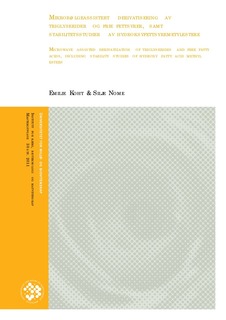| dc.description.abstract | A method for acid catalysed microwave transesterification of triglycerides was developed
with BF3 as catalyst. GC-MS was used for quantitative and qualitative analysis of fatty acid
methyl esters (FAMEs) obtained after transesterification. The yield in per cent of FAMEs was
calculated from their corresponding chromatogram areas against the area of an internal
standard.
It was noticed that the optimal power and reaction time was 70 W and 7 minutes with RSD <
10% for each FAME. This indicates good reproducibility and precision. The yield varied
according to FAME, so that the average yield (%) of the employed FAMEs (C16:1, C18:1,
C18:2, C20:1, C20:4, C20:5, C22:1 and C22:6) was 80% ± 12 with RSD equal 16%.
It was investigated if the acid catalyst HCl and the base catalyst CH3ONa could be more
suitable at microwave assisted transesterification than BF3 in respect of reaction time and
yield of FAMEs. HCl obtained a lower average yield at all the points of time and with almost
twice as high a value of RSD (30%). This means that BF3 obtained better precision of the
results and was therefore preferred rather than HCl. CH3ONa obtained an optimal reaction
time in 20 seconds with an average yield of FAMEs equalling 80% ± 17. Since CH3ONa
obtains a similar yield more rapidly than BF3 it is therefore more suitable as a catalyst in
microwave assisted transesterification.
In addition, it was investigated if microwave assisted transesterification with BF3 could result
in higher yield of FAMEs and shorter reaction time compared to a traditional method. The
traditional method involved the transesterification of triglycerides at room temperature with a
base catalyst, CH3ONa. The average yield of FAMEs obtained was 80% ± 17. Compared with
microwave assisted transesterification the yield was similar but the standard deviation and
RSD for the microwave method was somewhat lower. Since the microwave method is overall
shorter in duration, it is more beneficial.
An improvement of a method for acid catalysed microwave assisted methylation of even and
odd numbered free fatty acids from C4:0 to C18:0 was performed. This improvement
involved the use of ice baths after the metylation reaction to minimize loss of FAMEs with
chain length < C10:0. In addition, this method was compared with conventional heating methods by water baths. Even though ice baths was employed in both methods, continued loss
of FAMEs with chain length C4:0-C9:0 was observed, indicating that the employed system
was insufficiently closed.
A study of hydroxy fatty acid methyl esters' (OH-FAMEs) stability on GC-MS was performed
to investigate if these compounds can be detected and quantified with GC-MS. All OHFAMEs
analyzed was also detected, with the exception of 12-OH-FAMEs. Quantification
could not be performed because of wide and unsymmetrical peaks with low intensities | en_US |
